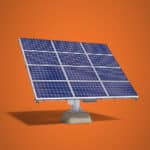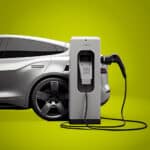- Handerson-Hopkins School, Baltimore, Maryland | Photo Credit: Will Kirk/John Hopkins University
In Baltimore, MD, a community school is using its rooftop to help school families and staff lower their electricity bills. The Elmer A. Henderson: A Johns Hopkins Partnership School (also known as Henderson-Hopkins) is the site for an innovative community solar project that will dedicate 100% of clean energy generated to the benefit of an estimated 150 low-to-moderate (LMI) income households in the community.
The Solar4Us @ Henderson-Hopkins project was funded and developed by the Climate Access Fund (CAF), a nonprofit green bank that provides equitable access to clean energy through discounted solar electricity and shared ownership of solar projects. Once the 804 kW community solar project goes online in fall 2024, it is expected to reduce electricity bills for subscribers by up to $200 per year. Over the lifetime of the project, the array is anticipated to save participating community members a total of $1.1 million.
Henderson-Hopkins School Stats
District: Henderson-Hopkins School / Baltimore City Public schools
Location: Baltimore, Marland
Solar Installation: 804 kw rooftop array
-
Generates enough power to serve up to 150 schools
-
Expected to save up to $200 a year per household
Henderson-Hopkins Principal, Peter Kannam, saw this project as a perfect fit for the school’s mission. “Henderson-Hopkins is located in an area of East Baltimore that is revitalizing after a long period of historical disinvestment. Our area’s median household income is under $30,000, and over 55% of our community’s children are living below the poverty line,” Kannam explained. “When Climate Access Fund approached us with the idea for LMI community solar, we quickly agreed to 100% of the power being reserved for LMI households and ensuring our school community and neighbors are prioritized.”
Solar4Us @ Henderson-Hopkins project has the capacity to serve approximately 150 households if all the energy generated is claimed. CAF is prioritizing access to subscriptions first for school families, followed by school staff. If subscriptions are remaining, then they will be offered to the broader East Baltimore community. In addition to financial savings, the installation of the array has provided valuable educational and job training opportunities. During the installation at the school, CAFs worked with a local non-profit to offer two on-the-job training experiences and a trusted local community member was hired to begin conducting outreach and educating neighbors about the benefits of subscribing to the local community solar project. Once the solar array is operational, Henderson-Hopkins has plans to incorporate the solar array into its existing curriculum.
Henderson-Hopkins School is setting a powerful example of how community solar can support education, climate justice, and community resilience, all while providing tangible benefits to families in need.
“It’s going to help generations to come. We’re a community school. We want to serve the community. [It’s] a win, win, win for the community, for our students, for the environment.”
-Peter Kannam, Principal of Henderson-Hopkins School















